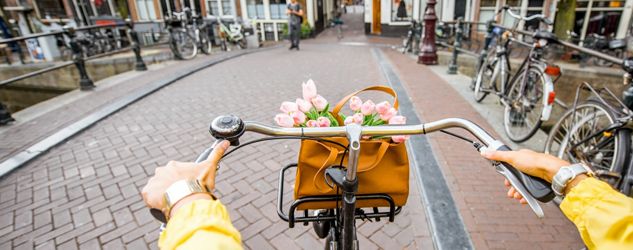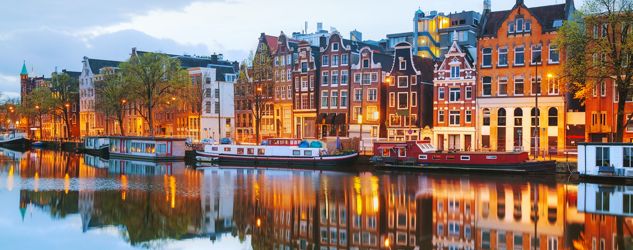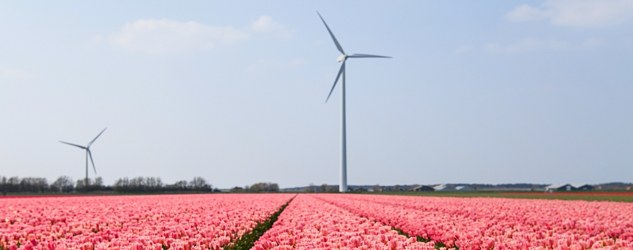There’s more to Amsterdam than coffee shops, the Van Gogh Museum and the Red-Light District. There are loads of cool things here that contribute to making the city one of the greenest and most environmentally friendly in Europe. Read on to find out why the capital of The Netherlands is synonymous with sustainability.
Get about by bike!

Holland has over 35,000 km of bike lanes so you can travel right across the country under your own steam. According to figures from the local branch of the International Cycling Union, one crossroads in Utrecht sees some 28,000 cyclists pass through every day. Total bike use in Holland is estimated to be the equivalent of each Dutch person pedalling some 880 km per year. And those aren’t the only stats that demonstrate the country’s commitment to pedal power, making it one of the greenest in the world.
So, it’s no surprise to learn that Amsterdam is one of the best cities in the world to get around on two wheels. In 2019, the Copenhagenize Design Company rated it second—behind only Copenhagen itself—of 150 international cities ranked according to efforts to implement cycling as an efficient means of transport.
The Dutch capital has around 500 km of bike lanes covering almost every corner and canal in the city. So, you can get around Amsterdam and keep your carbon footprint as small as possible just by getting on your bike. Take in the main sights or strike out on a longer trip along the banks of the Amstel river to Ouderkerk aan de Amstel, among many other places.
Canals and paddleboards

Amsterdam is well-known as ‘the Venice of the north’, and with good reason: over 100 km of canals, 1500 bridges spanning them and more than 2500 floating homes. The entire city is surrounded by water, which gives it its unique charm, particularly the 17th-century area where the historical value of the three concentric canals has led to them being declared a UNESCO World Heritage Site.
Even without this status, Amsterdam’s canals would still be an aesthetic wonder and home to more than one weird and wonderful sight, such as the famous bridge of 15 bridges on the corner of Reguliersgracht and Herengracht. The nickname is well-deserved: from the bridge, you can see 14 others (the 15th being the one beneath your feet). Come back after dark to get one of the most spectacular photos of Amsterdam for your Instagram.
The best way to experience the canals, however, is actually on the water, and there are as many ways to do this as there are canals. A river cruise is the typical thing, but it’s more fun and more sustainable to get around in a group by pedalo, kayak or even paddleboard (very trendy lately).
Zero CO2 emissions
The urgent need to halt global warming has led Europe to declare that the planet is suffering a “climate emergency”, according to the resolution passed by the European Parliament in November 2019.
Already one of the greenest cities and most committed to tackling the situation, Amsterdam aims to be the first European city to achieve zero CO2 emissions by 2050. It hopes to hit this target via strategies focusing first and foremost on sustainable mobility and eliminating CO2 emissions from public and private transportation.
The city is planning to replace all diesel busses with zero-emission ones, as well as increase the fleet of electric taxis. In parallel, financial packages are being put in place so members of the public can replace older vehicles with electric ones. The most polluting vehicles will also be restricted from accessing certain areas of the city. If it achieves its aims, Amsterdam will be one of the greenest capitals in the world.
Tasty leftovers

Food waste is a global problem: it’s estimated that around 100 million tonnes of food are thrown away in the EU alone. Apart from the ethical implications, this also has serious economic and environmental consequences since food production has a significant environmental impact.
So not wasting food is a good way to fight climate change, something Helsinki’s Waste to Taste collective has been saying since 2016. In Amsterdam, you can try out one of the international restaurants from the Instock chain that has come on board with the project.
In their environmentally friendly Amsterdam establishment, breakfast, lunch and dinner are all made with leftover food, so it ends up on your plate instead of in the bin. The menu offers diners the chance to try up to eight dishes made with different preserving techniques. One ingredient they’re not short on imagination, and the food is delicious. In the last four years, the Instock Restaurant team estimates they’ve saved a total of 480,000 kilos of food from being wasted.
Amsterdam for non-touristy tourists

Mass tourism also presents problems in terms of sustainability for cities, so more and more people are turning to alternatives to traditional tourism. The Untourist Guide to Amsterdam (editorial Querido and online) offers a number of alternative suggestions to explore the city with a difference.
This entertaining guide invites you to explore streets, markets, gardens, flea markets, shops and unique spaces away from the well-worn tourist trails of the free tours. Among other possibilities: planting vegetables in urban allotments, cookery classes, fishing rubbish out of the canals and even fun ‘wedding ceremonies’ with the locals.
A green airport

Running an airport can generate a massive carbon footprint unless minimal sustainability measures are in place. Fortunately, with the new century has come an increased awareness of the problem and more and more airports and airlines are making a big effort to reduce emissions.
Managed by Dutch group Schiphol, Amsterdam airport is a leader in this regard. Responsible energy consumption means efficient use, energy-saving wherever possible and using the cleanest possible electricity. Present in Amsterdam, Eindhoven, Rotterdam and Lelystad, the group has an agreement with an electricity supplier so its airports run solely on renewable energy generated in Holland. The aim for 2020 is to use energy generated by the country’s new wind farms.
But the most ambitious goal they’ve set themselves is to reduce CO2 emissions per passenger to 1.35 kg in 2020. And since they managed to get it down to 1.52 kg CO2 in 2017, it looks like they’re on the right track. That’s why arriving into an airport like this on the way to discover a city as thrilling as Amsterdam is a double bonus.







